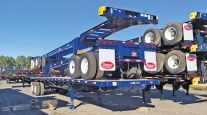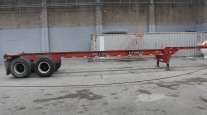Motor Carriers, Shipping Lines Clash on Effectiveness of Chassis-Safety Rules
This story appears in the July 25 print edition of Transport Topics.
Two years after truckers won a decade-long battle to win new federally mandated chassis-safety rules, broad disagreement about the effect of those changes remains, marketplace confusion reigns and operational issues are unresolved, according to trucking officials and consultants.
Tired of being saddled with equipment violations on shoddy chassis owned by ocean carriers, the truckers’ effort to make the owners provide safer equipment began in 1999. Six years later, the effort bore fruit and the Federal Motor Carrier Safety Administration started writing new rules that began taking effect in June 2009.
The results so far have been mixed.
On the one hand, drayage carriers and experts report business conditions border on the chaotic — using words such as “messy” and “very bad” to describe an evolving market with multiple ocean carrier chassis strategies.
Maersk Line, the biggest ocean carrier, ended the decade-long practice of giving draymen chassis for free and began renting them late in 2009. Meanwhile, free chassis are available from a pool maintained by other ocean carriers.
To further complicate matters, some pool participants have said they’ll eventually follow Maersk out of the chassis business, but only at some ports. Still other ship lines haven’t yet said what their chassis strategy will be.
“You need a scorecard to keep track of the market, and it changes every day,” Jeffrey Bader, president of Golden Carriers, Hillside, N.J., told Transport Topics.
“Right now, it is a very messy business model,” said Dan Smith of Tioga Associates, a consulting firm that did a federally sponsored study of intermodal drayage. “In the short run, it is a catch-as-catch-can situation.”
Joseph Tovo, president of DNJ Transportation, Cicero, Ill., went further, telling TT: “We are quoting different rates every other day [because of chassis uncertainty]. The onus for maintenance has been pushed on us.”
He also said that the situation as it has unfolded “is a very bad thing.”
On the other hand, ocean carriers and federal officials insist that the rules are working as intended, choosing words such as “progress” and “shared responsibility.”
“We have made a lot of progress,” said Jack Van Steenburg, the Federal Motor Carrier Safety Administration’s assistant administrator and chief safety officer, told TT, while also emphasizing some miscommunication remains (see related article, this page).
“I truly believe the IEP [intermodal equipment provider] rule is working,” Van Steenburg said, saying the chassis out-of-service rate has fallen to 17%, compared with as much as 26% before implementation began.
“There isn’t anything that has come about that wasn’t already spelled out in the regulations,” said Phil Wojcik, president of Consolidated Chassis Management, the free chassis-equipment pool operator. Its ocean carrier members comprise the Ocean Carrier Equipment Management Association trade group.
Jeffrey Lawrence, executive director of OCEMA, took a longer-term view, saying today’s market is “very typical of any period of change. There are a lot of variables. There is an educational process here. All of the parties here have the responsibility here to reach out and communicate.”
DNJ’s Tovo demurred.
“Not once have steamship lines or CCM come to truckers to talk about how things could work better,” he said. “I believe it is because they really don’t care what we want.”
As of July 1, FMCSA took the next step by launching so-called “roadability reviews” of chassis providers, which are the intermodal version of compliance reviews for over-the-road fleets. Van Steenburg said FMCSA’s first chassis reviews would be targeted at providers whose fleets had the most frequent violations.
A key reason for the unfinished transition, Smith said, is intermodal’s inherent complexity.
Because an intermodal move can have 10 or more participants, the chances of a smooth evolution are “close to nil,” he said.
Intermodal participants can include: origin and destination truckers, multiple ocean and rail carriers, two or more terminal operators, chassis and separate container lessors, a storage yard and a marketer who arranges the move.
By comparison, a truck move has as few as three actors — carrier, shipper and receiver.
Despite the multiple ocean carrier strategies and complex intermodal process, truckers are coping.
“Truckers are resilient,” Bader maintained. “As long as you give us a set of rules, we can live with them. When the rules change, that’s a problem.”
Curtis Whalen, executive director of the Intermodal Motor Carrier Conference of American Trucking Associations, agreed with Bader about intermodal truckers’ business approach.
“My members aren’t saying, ‘Woe is us,’ ” Whalen said. “Members are dealing with it. Change happens in business all the time.”
That doesn’t mean, however, that truckers are happy.
“A lot of equipment out there isn’t ready for prime time,” said Whalen, who hopes FMCSA’s reviews will be a wake-up call. “A lot of equipment providers haven’t understood what a systematic maintenance and repair program is supposed to look like.”
Whalen did credit CCM and other pool operators for making an effort, saying “they are trying to do a good job. Historically, they just flushed this stuff through the system [without repairs].”
Tovo didn’t agree with Whalen, calling CCM’s chassis “garbage equipment.”
Wojcik disputed those views, saying, “The condition of the equipment has improved significantly over five years. We have an excellent record.”
Van Steenburg credited chassis providers for their improving equipment, saying, “They have put a lot of investment into them. That is very encouraging.”
Bader acknowledged that equipment condition in general is improving, though there are still some problems because of tire condition and light malfunctions.
Both Tovo and Bader praised Maersk’s chassis rental program because its chassis are in top condition and can be used for any container shipment.
Operational and financial problems arise, Tovo explained, when an ocean carrier doesn’t permit its chassis to move other lines’ freight.
As a result, truckers may be stuck with moving an empty chassis up to 70 miles to return it to a designated location, instead of simply putting a new load on after one is delivered.
Greg Stefflre, CEO of trucker Rail Delivery Services, Fontana, Calif., outlined multiple operational and financial challenges.
For example, customers who receive intermodal freight don’t want to be bothered with managing chassis, he said.
That means truckers could be saddled with the task of providing chassis that now can sit for up to 20 days at a shipper’s dock before the ocean carrier begins to collect demurrage charges.
“The trucker has only a tiny piece of the move and has no leverage,” Stefflre said, which mean motor carriers can’t force shippers to inspect or maintain chassis.
A typical drayage move generates about $200 of revenue, Stefflre said. By comparison, the average rate to ship a container from Asia to the United States is about $2,500.
If truckers become responsible for chassis, Stefflre said, the level of complexity will rise even further when a shipper asks the trucker to pull a load that’s sitting on a chassis owned by another motor carrier.
Finally, he added, there is the land-use issue.
“If you get all these chassis, where the hell do you put them?” Stefflre said, noting that chassis take up valuable space. Land is so valuable in Southern California, he said, that a chassis vendor tried to convince truckers to come and get them in Barstow, Calif., 120 miles from the port.
“They [ocean carriers] are transferring not just the cost, but also the storage responsibility,” Stefflre concluded. “No wonder they want to get rid of this [stuff].”
Change also creates documentation consequences, though some of them have been mitigated.
Van Steenburg noted that the paperwork burden was reduced by eliminating an earlier requirement that truckers file inspection reports on all equipment, defective or not. Now that requirement is limited to defective chassis that may be just 1% of the total.
Tovo noted that the trucker is losing money whenever there is a billing dispute because he isn’t paid until the matter is resolved.
Smith highlighted the new paperwork required by the rule. Drivers now do pre-trip inspections, which generate paperwork, and repairs also have to be documented, adding more paperwork.
“The rule has shifted more administrative and cost burden onto the people who operate the equipment,” he said. “Nobody likes that.”
The added paperwork helped “tip the scales” in many ocean carriers’ decision to exit the chassis market, Smith added.
One financial factor hasn’t changed. Drivers still have an economic incentive to make the run as quickly as possible because they are paid per trip.
That gives them an incentive not to incur delays to wait for chassis repairs, Smith said, and costs them money when they fill out paperwork instead of driving.
OCEMA’s Lawrence maintained that ocean carriers are pursuing multiple, effective approaches.
“The lines have tried hard to make [chassis evolution] an open and flexible process, and let the system evolve toward the most efficient path,” he said. “They are developing the infrastructure to support whatever business model the truckers want to utilize.”
At the same time, Lawrence said, “there is a general sense [among OCEMA members] that there should be a change to move toward a model more consistent at the rest of the world” — where truckers own and manage chassis.
One long-term solution, Wojcik said, is further enhancements to the CCM pool, which manages at least 130,000 chassis.
“OCEMA members are completely in support of going forward with the CCM structure,” Wojcik said, in concert with individual carriers’ own independent chassis strategy.
CCM membership now is being opened to motor carriers and shippers as well as ocean carriers, he added.
Lawrence noted that CCM’s staff has grown from eight to 120 people and that computer and pool-management improvements have enhanced its viability.
Others believe pools are the long-term solution — but with truckers in control.
Smith said a trucker-controlled pool will evolve as drayage fleets draw equipment from pools for short-term needs and own or lease chassis for longer-term business, much like the rest of the trucking industry does.
Tovo said the Illinois Trucking Association is working on a so-called “gray” pool of chassis that could be used by any drayage carrier.
“We need one chassis pool that isn’t looking to make a massive profit off repairs,” Tovo said. “Someone has to come up with a pool that isn’t a profit center.”
Tovo said he hopes that pool could emerge as early as next year.
“Until that happens, chassis will be in forefront for me and my customers,” he said. “The market is just too fragmented right now.”




